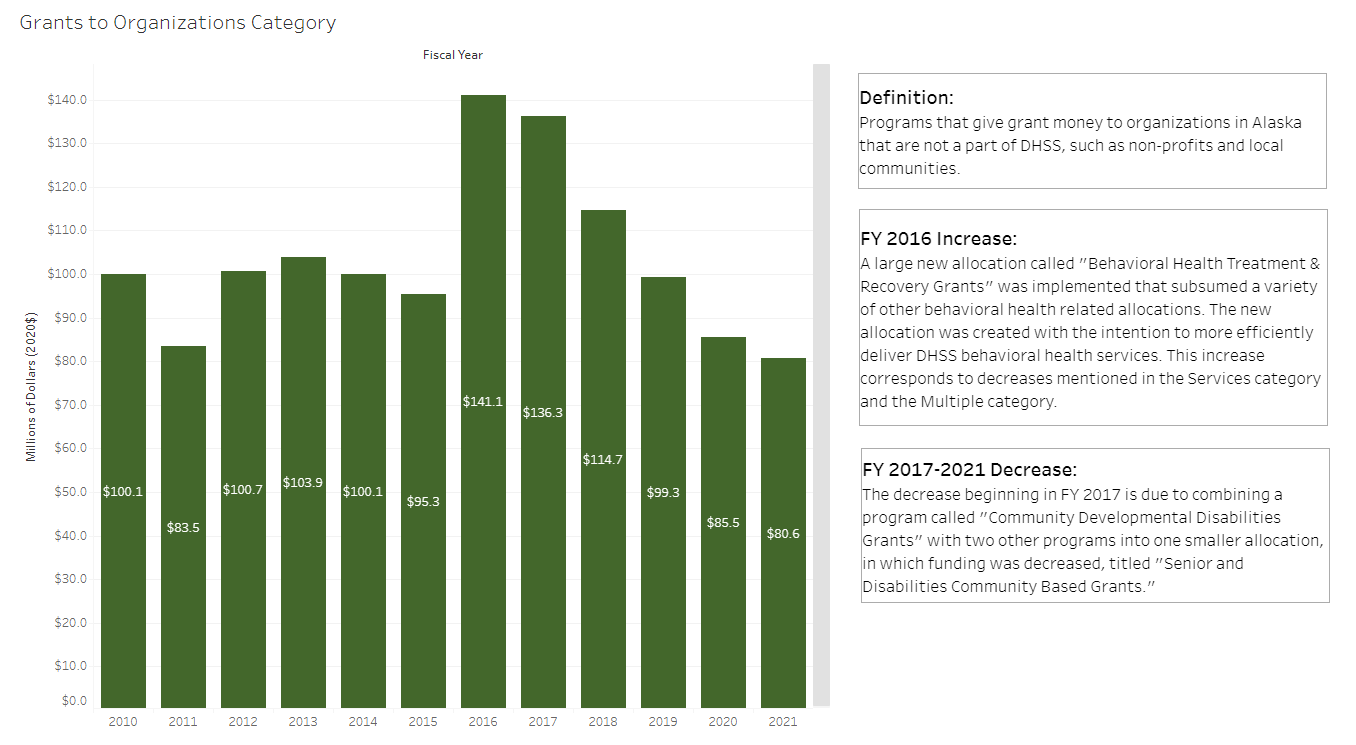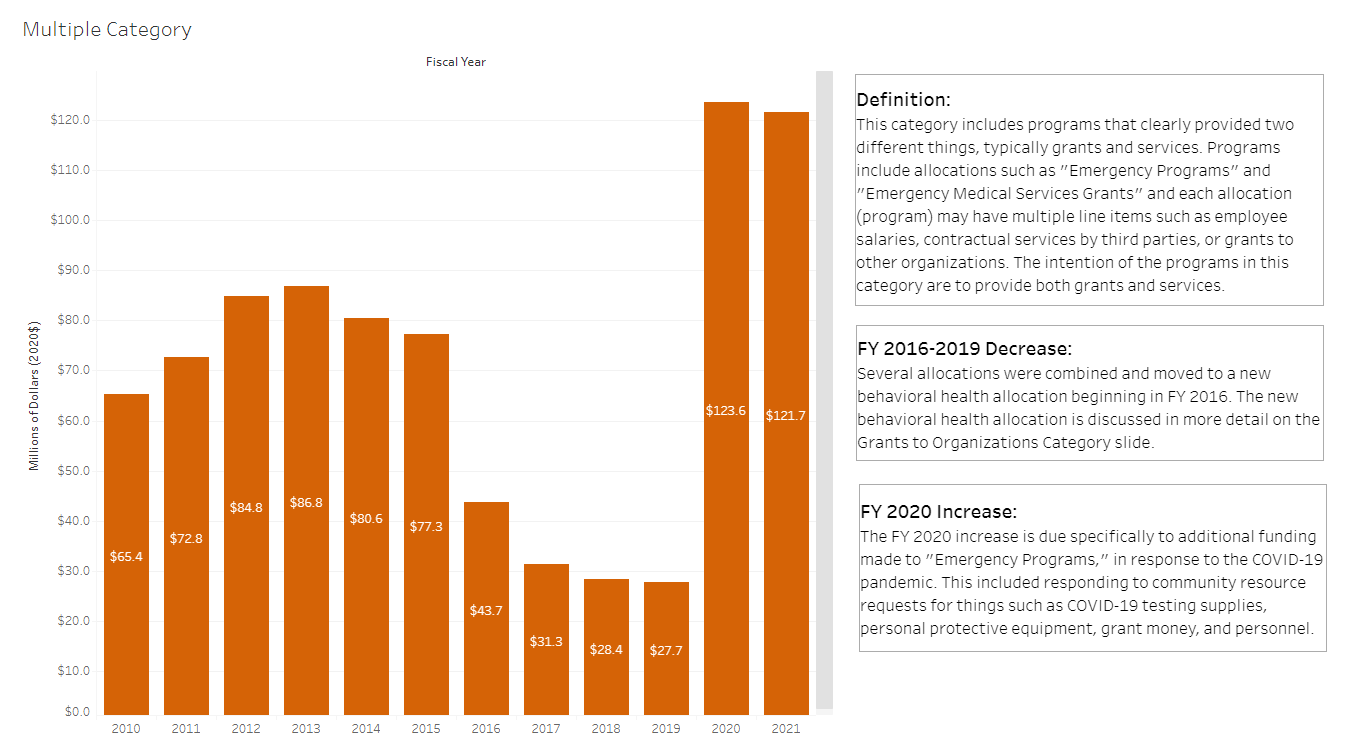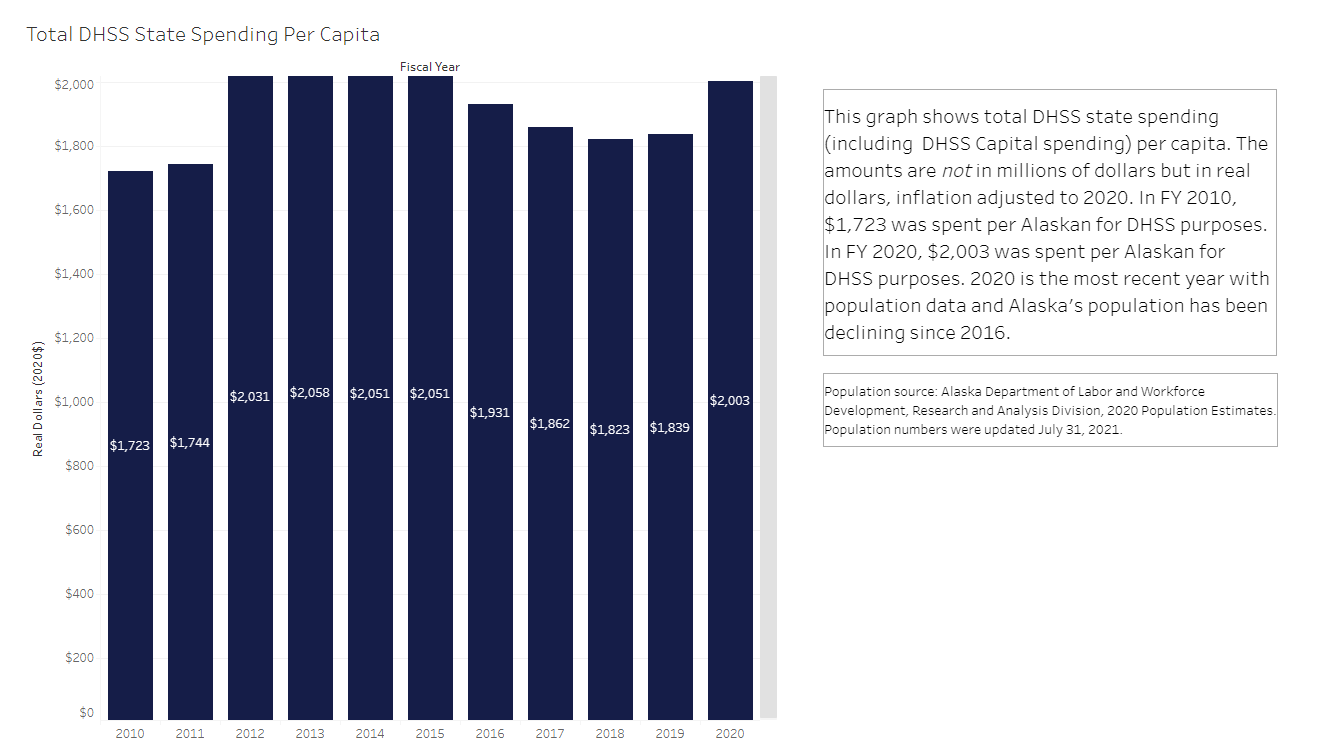Click here to view the interactive graphs (detached from the full report)
For many years, the Department of Health and Social Services (DHSS) has required one of the largest portions of state spending, second only to the Department of Education and Early Development. In this project, Alaska Policy Forum (APF) examines what DHSS dollars are spent on and how the spending has changed over the years.
Budget Basics
For this report, we examine DHSS state spending, which includes supplemental spending and DHSS capital spending. For the purpose of this report, state spending excludes federal receipts, the Permanent Fund Dividend (PFD), and fund transfers. For further information on the differences between total state spending and the budget, please refer to “Debunking the Myth of Alaska’s ‘40% Budget Cuts.’”
Due to recording differences, DHSS total state spending was not reported in the Allocation Totals in FY 2014 or FY 2015. Instead, the enacted budget amount was provided, which means that supplemental spending is not included for those two years. Keep this in mind as you compare across years – FY 2014 and FY 2015 total spending is likely more than is represented in this report.
Total Categories
This graph shows total DHSS state spending between FY 2010 and FY 2021, inflation-adjusted to 2020, separated into six categories. The purpose of separating DHSS spending into categories is to help conceptualize the types of things Alaska spends money on.
A state department’s budget is broken down into a variety of subcategories called appropriations and allocations. An appropriation is a group of programs or activities that has a similar goal. Appropriations usually correspond to a division within the department. For example, one DHSS appropriation is Behavioral Health, which encompasses the Behavioral Health division. Appropriations are made up of smaller allocations, which correspond to programs within a division. For example, there are several allocations for the Behavioral Health division, one being the Alcohol Safety Action Program (ASAP). Each of the six categories in this report is made up of related allocations. Additionally, allocations (programs) may have multiple line items for expenditure categories such as staffing costs, travel for employees, the service the program is providing (such as a food memo for the Adult Alcohol Drug Information School, a service provided by ASAP), employee office equipment, contractual services by third parties, or grants to outside organizations or individuals. Often, new allocations are submitted in the governor’s budget by the departments and then codified when the budget bill passes the legislature, and the governor signs it into law. Other times, the legislature may pass a bill that requires a new allocation.
Allocations that make up the Medicaid category are clear cut, but the other categories are subjective. Each allocation was selected for a category based on the program’s mission and description of main services, as found in the corresponding budget book prepared by the Office of Management and Budget. It is important to note that while how allocations are placed in categories is mostly subjective, the total amount of DHSS dollars spent is not subjective. The categories are simply a way to help show where changes in spending have occurred, while also conceptualizing what kinds of programs are being funded.
Medicaid
Medicaid is a welfare entitlement program aimed at providing government-funded health care to certain low-income individuals. It covers a wide variety of health care services by reimbursing health care providers or facilities for the covered services. The FY 2012 increase in Medicaid spending is due to the federal Affordable Care Act (2010), which induced growth in Alaska’s Medicaid enrollment. In 2015, Alaska fully expanded Medicaid via executive order, so the decrease seen in FY 2016 is a result of federal funds increasingly covering state Medicaid costs. That federal funding is separate taxpayer dollars not provided in this analysis.
Services
The Services category is a large bucket of programs that provide services to Alaskans and includes things such as assisted living residences, youth facilities, and programs for early intervention and infant learning.
The decrease between FY 2016 and FY 2018 is due to an allocation titled “Services to the Seriously Mental Ill,” which was rolled into a new behavioral health allocation that can be seen in the Grants to Organizations category. The service provided by the original allocation was not ended, as the funding for it and several other behavioral health allocations were simply compiled into one larger allocation in the Grants to Organization category that began in FY 2016.
The increase in FY 2020 is due to a new allocation proposed by DHSS titled “Alaska Pioneer Homes Payment Assistance” which provides a payment assistance plan for seniors who are unable to pay the monthly fee themselves to live in the Pioneer Homes. While some new allocations are created due to bills passed by the legislature, often, new allocations are proposed by departments in the governor’s budget and then codified when the budget bill passes the legislature and the governor signs it into law, which is what occurred here.
Administrative
The Administrative category includes the day-to-day running of DHSS, including IT management, advisory boards, facilities management, and more. State spending on the Administrative category of DHSS has steadily increased over the last decade, particularly in FY 2018 and onward. This is due to a variety of reasons, such as a new administrative approach to systems in the Behavioral Health Division beginning in FY 2019. Another example is the administration of a marijuana education program in FY 2020 by the Public Health Division.
Cash Grants
The Cash Grants category contains programs that provide financial assistance to Alaskans, such as foster care subsidies, grants for adoptions, and a payment program for seniors.
The steady decrease in Cash Grants from FY 2016 to FY 2021 is due mainly to a decrease in the Alaska Temporary Assistance Program allocation, which is provided under the federal Temporary Assistance to Needy Families (TANF) grant program. This is occurring because the number of grant recipients is decreasing. According to DHSS, it is unknown why the number of ATAP recipients is decreasing.
Grants to Organizations
The Grants to Organizations category comprises programs that give grant money to organizations in Alaska that are not a part of DHSS, such as non-profits and local communities.
In FY 2016, a large new allocation called “Behavioral Health Treatment & Recovery Grants” was implemented that subsumed a variety of other behavioral health related allocations. The new allocation was created with the intention to more efficiently deliver DHSS behavioral health services. The total spending for these various programs did not necessarily increase substantially, but the various programs all became one program that fits best under the Grants to Organizations category. This increase corresponds to decreases mentioned in the Services category and the Multiple category.
The decrease beginning in FY 2017 is due to combining a program called “Community Developmental Disabilities Grants” with two other programs into one smaller allocation, in which funding was decreased, titled “Senior and Disabilities Community Based Grants.”
Multiple
This category includes programs that clearly provide two different things, typically grants and services. Programs include allocations such as “Emergency Programs” and “Emergency Medical Services Grants” and the intention of the programs in this category are to provide both grants and services. This report examines spending at the allocation level, not the line item expenditure level, so an analysis of how much funding in these particular programs is going towards grants versus services is not available.
Several allocations were combined and moved to a new behavioral health allocation beginning in FY 2016. The new behavioral health allocation is discussed in more detail in the Grants to Organizations section.
The FY 2020 increase is due specifically to additional funding made to “Emergency Programs,” in response to the COVID-19 pandemic. This included responding to community resource requests for things such as COVID-19 testing supplies, personal protective equipment, grant money, and personnel.
Per Capita
This graph shows total DHSS state spending per capita. The amounts are not in millions of dollars but real dollars, inflation-adjusted to 2020. In FY 2010, $1,723 was spent per Alaskan for DHSS purposes. In FY 2020, $2,003 was spent per Alaskan for DHSS purposes. 2020 is the most recent year with population data and Alaska’s population has been declining since 2016.
Conclusion
As seen in the previous graph, total DHSS state spending has increased since FY 2010. More importantly, per capita spending has increased, meaning the state is spending more on health and social services per Alaskan. This is mainly due to the increased cost of Medicaid under ACA. However, Alaska is also spending additional money on bureaucracy (the size of government) and programs that are not paid for in other states, such as state assisted living homes.
Some key takeaways from this analysis:
- ACA and Medicaid expansion have put Alaska on the hook for an enormous amount of money.
- Bureaucracy and the cost of government within DHSS have increased.
- State spending is not as transparent as it should be – the Allocation Totals report from LFD changed formats in FY 2014 and FY 2015, making it difficult to find total DHSS spending by allocation for those years. Additionally, many of the details of spending changes were not made apparent in documentation available for the public, such as the LFD reports and the OMB budget books.
Overall, while some allocations (programs) have been combined or slightly decreased over the years and the Capital Budget has been minimized, total state spending for DHSS has increased. In fact, DHSS is the second-costliest department in Alaska state government. Additionally, per capita spending has increased. This analysis has served to highlight which programs may be driving the changes to DHSS spending and also helped to conceptualize the types of programs being paid for by Alaska.








